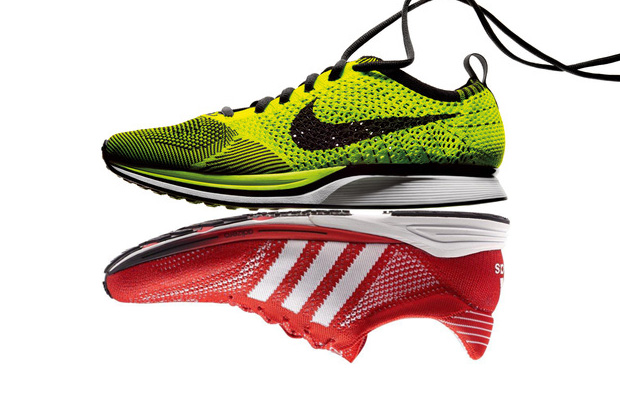20 years ago, Nike set out to craft a shoe that would deliver peak performance for athletes while reducing manufacturing waste in the process. Inside Nike’s ultra-secretive Beaverton, Oregon headquarters, this shoe would be born from years of intensive research and development, and expenses that then-CEO Mark Parker thought the $106.8 billion sportswear giant might never be able to meaningfully recoup. In February 2012, after countless hours of labor and innovation, Nike debuted what was deemed to be the most momentous innovation in the fiercely competitive, and multibillion-dollar-earning sneaker market in years: its Flyknit technology. The “groundbreaking” shoes were destined to take center stage at the London Summer Olympics, which were just months away.
The technology at the heart of Nike’s newest shoes saw yarn and fabric variations used together to engineer “a featherweight, formfitting and virtually seamless upper.” In addition to “a precision fit,” the woven upper of Flyknit footwear – the first sneakers to bear an upper that consists of a single piece of material, as opposed to one derived from different pieces stitched together – was noteworthy, as it resulted in little to no waste in the manufacturing process.
With roots at Nike that date back to at least 2000, when the Oregon-based sportswear giant made its very first prototype in furtherance of its quest to create a sneaker with a woven-fabric upper, the technology represents “the right direction for Nike, from both a bottom-line and an environmental perspective,” Parker told the Wall Street Journal in 2015. And it has performed. In the first five years after its initial release, sneakers that bear the Flyknit technology brought in upwards of $1 billion in sales for Nike.
Within five months of the debut of the Nike Flyknit came another striking development: adidas unveiled knitted footwear of its own, a collection it referred to as “Primeknit.” Hailing the product as “a first-of-its-kind running shoe,” adidas’ Primeknit was created from a method that involves digitally knitting a single piece of fused yarn to create a single-thread upper and reduce material waste. In doing so, adidas was not merely presenting a hot-selling new collection of shoes to its roster, it was starting a legal war that has been underway ever since.
The latest development in the ongoing fight that is Flyknit v. Primeknit comes from the U.S. Court of Appeals for the Federal Circuit and centers on a utility patent (7,347,011) that was issued to Nike in March 2008. The patent, which Nike filed for in 2004, extends to “an article of footwear and a method of manufacturing the article of footwear.” In essence, the patent protects some of the most valuable aspects of Nike’s Primeknit technology, and Nike and adidas have been sparring over the patent – which covers footwear with an “upper” that is made from a knitted textile using any number of warp knitting or weft knitting processes – since 2012.

By way of an IPR proceeding – one in which the U.S. Patent and Trademark Office’s Patent Trial and Appeal Board (“PTAB”) reviews the patentability of one or more claims in a patent, adidas argued back in 2012 that Nike’s patent is invalid based on another party’s patent application from 1991, which discloses a process for creating uppers that are cut from a web of textile material and then shaped and connected to a sole. As a result of the prior art, adidas argued that the claims in Nike’s patent were “obvious,” and thereby, fail to meet one of the primary pre-requisites to patent protection.
The PTAB instituted a review of the patent and shortly thereafter, Nike sought to cancel some of the claims in its patent – and substitute them with new claims – in order to clearly distinguish its Flyknit technology from the prior art of record (i.e., information that has been made available to the public in any form before a given date that is relevant to a patent’s claims) and establish novelty.
While the PTAB granted Nike’s motion to cancel an array of its claims, it refused to allow the sportswear giant to add in substitute claims on the basis that Nike failed to show that the substitute claims were not obvious compared to the prior art, prompting Nike to appeal the decision to the Federal Circuit in 2014.
After vacating parts of the PTAB’s decision, the Federal Circuit remanded the proceeding back down to the patent body, which determined that adidas’ substitute claims that focused on “apertures formed by omitting stitches” were invalid based on additional prior art, namely, a knitting technology handbook by Spencer, which was not previously cited by either adidas or Nike. The handbook showed a technique related to the omitting of stitches in order to create holes for shoe laces, which is at the heart of Nike’s substitution claims, thereby, making Nike’s claims “obvious.”
With such prior art in mind, the Federal Circuit held that Nike’s claims were invalid, prompting Nike to lodge another appeal to the Washington, DC-based appeals court, taking issue with the PTAB’s reliance on the kitting handbook without informing the parties of such prior art. (To be exact, Nike argued that the PTAB ran afoul of the Administrative Procedure Act’s notice requirement).
Nike also challenged the PTAB’s finding that its “evidence of long-felt but unmet need was insufficient to establish the nonobviousness of substitute claims.”
In a decision issued in the long-running matter this month, the Federal Circuit’s 3-judge panel sided with Nike, holding that the PTAB may, in fact, cite prior art or other invalidity grounds not raised by the challenging party (adidas, here). “Because this case involves a motion to amend, we conclude that the [PTAB] should not be constrained to arguments and theories raised by the petitioner in its petition or opposition to the motion to amend,” the Fed Circuit stated. “It makes little sense to limit the [PTAB], in its role within the agency responsible for issuing patents, to the petitioner’s arguments in this context.”
However, the court held that if the PTAB doe, in fact, look beyond the petitioner’s arguments, it must provide notice of its doing so to the parties, and provide them with an opportunity to respond before it issues a final decision.
Because it failed to provide such notice, the Federal Circuit vacated the PTAB’s decision as the substitute claim, and remand the matter back to the PTAB “to determine whether that claim is unpatentable as obvious after providing the parties with an opportunity to respond.”
*The case is Nike, Inc. v. Adidas AG, 19-1262 (Fed. Cir.).














